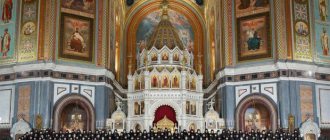The Slavs are pious people who reverence spiritual power. Even in the world of innovative technologies, the church occupies a special place in the lives of many Russians. A person within its walls seeks harmony and tranquility, and the clergy help to achieve peace. They bear the heavy burden of a person who is able to forgive sins, listen to the parishioner, and understand.
Priests play a special role in the life of the church. They are the ones who conduct most of the rituals (baptizing children, giving communion, marrying couples, etc.). The Bible says that the work of a priest should be free of charge and performed solely at the call of his heart.
However, in modern reality everything is different. There is no official salary rate for a priest. Their salary consists of the help of sponsors, alms from parishioners, and proceeds from the sale of church equipment - icons, candles, etc.
Let's find out how much priests earn and who pays their expenses? What are the salaries in Moscow and St. Petersburg?
What is the income of the Russian Orthodox Church
The Russian Orthodox Church is essentially a giant corporation with an extensive network of regional offices in all corners, even the most remote from the center. A very rich and extremely influential corporation. A corporation that has significant tax benefits and uses this to generate enormous income. But since the institution of the church, as we have already mentioned, is very closed, it is not possible for the general public to obtain reports on the items of the church’s income and expenses.
We only have indirect indicators. Several years ago, information was publicly available that the church’s annual income from donations, various ceremonies, and the sale of various printed materials amounted to 5.6 billion rubles. Let us remember that this income is not subject to income tax. Since then, this figure has clearly only grown.
In addition, the church regularly receives targeted financial support from the state aimed at the implementation of specific cultural programs, various projects, the functioning of funds and restoration activities.
How is the church budget formed?
The rector manages the funds. This is the head of a legal entity - an Orthodox religious organization in a certain area. Temples are registered in accordance with the procedure established by the legislation of the Russian Federation as non-profit organizations. They have their own charters and accounting.
Parishes exist on donations from parishioners and parishioners. People buy candles, icons, notes, and other items, order services (sacred rites performed upon request, for example, consecration, baptism, wedding). By purchasing a cross, a person essentially makes a donation in the recommended amount. If we consider this operation legally, then it is impossible to return the religious accessory, since it was received free of charge. The abbot also decides what amount to set for certain goods.
In summer, church income is lower than at other times of the year. People go on vacation and do more personal things. The most profitable times are church holidays, especially Easter, Christmas and Epiphany. In large cities, more money is donated. In villages, grandmothers can bring food from their own garden, some preparations and things. Temples in regional capitals can collect income of about 1–2 million per month. In Moscow there are even more. Sometimes entrepreneurs donate building materials to the church, pay utility bills, or provide other material and non-material assistance.
In addition to regular donations, money is also deposited into a bank account. This must be recorded in accounting documents. The funds received can only be spent for their intended purpose. Directions for spending are prescribed in the Charter.
Spiritual education
What does it take to become a priest? First you need to receive higher spiritual education. Educational institutions training priests are:
- Orthodox University;
- theological Seminary;
- Theological Academy.
The training lasts a standard five years. The most prestigious educational institutions in the industry are the Russian Orthodox University, the Trinity-Sergius Academy and the Theological Academy in St. Petersburg.
To become a clergyman, you must meet the following requirements:
- believe;
- graduate from a theological seminary or academy;
- have a recommendation from a current priest;
- be over 30 years old;
- be a regular parishioner of the church;
- know the basic spiritual scriptures, creations and deeds;
- reach the age of thirty;
- get married, and only once;
- know the Church Slavonic language;
- Constantly monitor the neatness of your appearance.
Historically, in Russia, priests often perform the work of a psychologist. It is not without reason that psychology is one of the disciplines that, along with specialized subjects, is consistently and thoroughly studied in religious educational institutions. The priest listens to the person, delves into his problem and advises a solution based on his understanding of the situation and guided by the traditions of the Orthodox faith.
To make a career in the church line, it is very important to be sociable, to be able to build relationships with superiors and to be ready to go through all career steps. As practice shows, the best careers in the structure of the Russian Orthodox Church are made by people who are assertive and loyal to management. These people are promoted and even given the opportunity to jump over some career steps.
Where do they study to become priests?
To obtain the “profession” of a priest, you need to graduate from a higher educational institution that specializes in training future church workers. This is a theological seminary, academy or Orthodox university.
The duration of training is 5 years. Students study theology, the foundations of faith, the Bible and its history, pastoral pedagogy, sect studies (a branch of knowledge that deals with the study of sects), etc. But the main subject is psychology.
Upon completion of training, graduates undergo an internship in a church. A mentor is assigned to them. When certifying a graduate, the mentor’s word is decisive, and only then he is given the status of a priest.
The nature of the clergy's income
The priest's income is formed in a unique way. Orthodox clergy receive a certain percentage of the income received by the church in which they serve. The nature of income, as we have already found out, can be different:
- sponsorship fees;
- voluntary donations from parishioners;
- income received by the church from the sale of various products (mainly candles, icons and printed materials)
- money collected for services rendered and other commercial activities;
Each church shop brings constant and unrelenting income to its parish. Of the total income, the rector sends 20% to the diocese, and the rest of the money is spent on paying for utilities and forming a wage fund.
Initially, the salary of a priest is correlated with the average salary of social workers in a given region. But this guideline is conditional.
Wage level
In Russia, the average monthly income of priests is 40,000 – 55,000 rubles, depending on the region:
- Moscow – 150,000 – 1,000,000 rubles;
- St. Petersburg – 50,000 – 500,000 rubles;
- Primorye – 100,000 rubles;
- Krasnoyarsk Territory - 52,000.
In the regions, a cleric’s salary is less – from 20,000 to 50,000 rubles. A novice priest begins ministry with an income of no more than 35,000.
Abroad, the monthly earnings of clergy are made up of deductions from the church fund (church tax), for example:
- Czech Republic – 600 euros;
- France – 950 euros;
- Belgium – 2500 euros;
- Italy – 700 euros;
- Spain – 850 euros.
The income of a Russian priest is unstable and depends on many factors, so it is difficult to give exact figures. In some remote villages, priests do not receive wages at all; they work for the Glory of God. But despite the difficulties of serving, the ideal of a priest - a good shepherd - is high, although the path to it is very difficult.
You can learn more about the salary of a priest in the video below.
about the author
Grigory Znayko Journalist, entrepreneur. I run my own business and know first-hand the problems and difficulties that individual entrepreneurs and LLCs face.
Rituals and sacraments performed by Orthodox priests
Baptism
The sacrament of baptism is the very first church rite in a person’s life. Baptism can be performed at any age. But the Russian Orthodox Church more welcomes the baptism of a child in infancy. During the ritual, the baby is immersed in water three times. Older people are simply sprinkled with holy water. Godparents must participate in the ritual - people chosen by the parents who undertake to assist in raising the child and introducing him to the faith.
Confirmation
This ritual is performed after baptism. It can only be performed by an Orthodox priest. This process involves anointing a person's ears, eyes, nose, hands and feet with holy oil. It is believed that only after this procedure does he fully join the Orthodox Church. Confirmation is also performed for those of other faiths who convert to Orthodoxy.
Confession
Repentance, or the sacrament of confession, usually precedes communion. Confession is conducted individually with a priest and is entirely voluntary. Before confession, the priest usually reads a prayer, thereby setting the believer in the appropriate mood. After the prayer, the person expresses what has accumulated in his soul and confesses to the priest the sins he has committed. After the end of the ceremony, the priest covers the head of the believer with an epitrachelion - part of the vestment that the priest wears around his neck. The priest makes the sign of the cross, and the man kisses the Cross and the Gospel. What is revealed to the priest during confession cannot be passed on to third parties.
Participle
Communion is the main rite of worship and is accompanied by a sermon by the priest. During the ceremony, parishioners take bread and wine from the hands of the priest. These products symbolize the body and blood of Jesus Christ. The ritual serves as a reminder of God's self-sacrifice and love for others. According to church dogma, regular communion brings a person closer to the Lord.
Wedding
When a marriage is concluded, a wedding ceremony takes place between believers. According to the canon, during a wedding, the Holy Spirit descends on a couple and strengthens their bonds. The ceremony is held only on Mondays, Wednesdays, Fridays and Sundays. Only married baptized people are allowed to attend the wedding. Men over 70 and women over 60 can no longer get married.
Priesthood
With this sacrament, a person receives holy orders and himself receives the right to conduct Orthodox rites and sacraments. This sacrament is necessarily preceded by the confession of the person receiving the ordination and the sacred oath. After carrying out these actions, the bishop decides whether this Christian is worthy to receive the rank. There are three degrees of priesthood:
- Deacon
- Presbyter or priest
- Bishop or bishop
Unction
This ancient sacrament of the Orthodox Church is designed to heal bodily and mental illnesses. It is in general terms similar to repentance, but unlike it, it frees a person even from sins that he forgot to mention. Since holy oil is used in the rite, its name is triple the consecration of oil. Usually several priests participate in the unction.
Job responsibilities
A priest is not just a person who reads sermons, takes confession and admonishes his flock.
The parish priest must perform six Sacraments of the church in the parish (the seventh Sacrament is the Priesthood - Ordination, which can only be performed by a bishop, who is a clergyman of the highest degree):
- Baptism. Through this Sacrament a person becomes a member of the Church. From this moment on, he has the right to pray for himself, his loved ones and the entire Orthodox world. After Baptism, a person can receive Holy Communion for the first time.
- Confirmation. Immediately after Baptism, the priest schematically applies myrrh to the human body in the form of a cross - a specially prepared oil with incense, consecrated by the bishop.
- Communion. During the sacred rite, the consecrated wine and bread are “transformed” into the Blood and Flesh of the Lord. This is the most important church Sacrament.
- Confession. This is repentance before the priest. During the Sacrament, Christ stands invisibly before the confessor; it was He who commanded the disciples to forgive the sins of their flock.
- Wedding. Blessing the marriage union between a man and a woman for a prosperous family life. This Sacrament symbolizes the union of Christ and the Church, and the newlyweds receive the grace of the Holy Spirit.
- Unction. A sacrament designed to heal mental and physical illnesses. It is carried out both for healthy people (in church) and for seriously ill people (at home, in hospital). The reading of prayers is accompanied by the application of consecrated oil to certain areas of the body in a cross shape.
In addition to performing the Sacraments, the parish priest conducts divine services, teaches pastoral blessings, teaches parishioners the basics of the Orthodox faith, serves custom prayer services, performs funeral services for the dead, and blesses homes.
Career
The church hierarchy is not obvious to lay people. In short, there is a division between clergy and clergy. Clergy are the lowest level of the hierarchy; these people can only help conduct services. To become a clergyman you need to be ordained. This procedure makes it possible to perform sacraments and rituals. The clergy are:
- deacons;
- priests (priests);
- bishops;
- bishops;
- archbishops;
- metropolitans;
- patriarch.
A young man who graduates from seminary becomes a subdeacon before being ordained. And only then does he become a deacon. How quickly a person will climb the career ladder depends on the data and abilities of a particular person. Connections are of great importance. The Russian Orthodox Church is a fairly closed system. Usually one becomes a clergyman no earlier than a person turns 21 years old. It is important to find a place for yourself in the temple and to please the abbot, after which there are no special obstacles to initiation.
What are the secular expenses of priests
Outside of work, priests can lead a completely ordinary social life. They spend their budget on renting an apartment or mortgage, on home improvements, gasoline, food and recreation. Part of the funds is also set aside for large purchases. Often a large expense item is the maintenance of children, since in such families there can be many of them.
their own housing on their own. Rarely rich temples have service apartments for their workers. This occurs as an exception.
Food can cost about 15–20 thousand rubles. Depends on the region. As a rule, food expenses are small, because some of the food can be taken from the church. People bring them to perform remembrance ceremonies. Cereals, bread, vegetables, sweets, and Cahors are often available.
A lot of money is spent on fuel and car maintenance . This is due to frequent trips to services. They have to take with them special clothing and items for performing rituals. It can cost about 20 thousand rubles per month to maintain a car.
As for clothes . The cassock and cassock wear out quite slowly, so they are bought once every 5–10 years. They cost 15 and 10 thousand rubles respectively. The priest's vestments and other specific accessories are purchased at the expense of the parish.
Many clergy go to the gym . This is not just a health concern, but a vital necessity. Divine services last for many hours, during which you need to stand practically without moving. This requires physical strength and endurance. Over time, the lower back begins to hurt and other health problems appear. Therefore, you need to monitor your physical condition.
According to the norms of the Labor Code of the Russian Federation, ministers are also entitled to a full vacation of 28 days. It is important to agree in advance so that the dates do not coincide with another priest who will replace him. You can choose the place and type of vacation at your discretion. Upon reaching retirement age, it is not necessary to resign from your position. It is not prohibited to work into old age. Health or other serious life circumstances may force you to leave the church.
moneyzz.ru
Heading:
People and money. About personal finance and success stories
Tags:
SALARY PERSONAL EXPERIENCE WORK SAVINGS
How much do priests earn?
As we know, the salary of an employee of a commercial company or organization directly depends on his immediate supervisor. There is a similar situation in the church - the amount of remuneration for a priest depends on the favor of the rector of the church towards him.
In Russia, the salaries of clergy vary dramatically. A priest in a small Ural village and a priest in the Cathedral of Christ the Savior receive absolutely money that is even strange to compare.
In rural churches in the Russian outback, a clergyman receives on average about 15 thousand rubles. The average salary of Orthodox priests in our country is approximately 65 thousand rubles.
Ordinary clergy in the capital receive an average income of 100 thousand rubles per month. The rectors of small Moscow churches have an income of at least 300 thousand rubles. In large metropolitan parishes, the income of a rector can exceed a million rubles.
What does a priest's income consist of?
The amount of money that the priest earns is a cumulative value. It consists of a fixed income that the priest receives based on planned revenues to the temple budget through payment for wedding services, baptism, etc.
Church parishes are often engaged in commercial activities and have their own production, the income from which also replenishes the church treasury and affects the amount of income of the priest.
Monastic cakes and bread sold to church parishioners are one of the income items
In churches where there are wealthy parishioners, a significant part of the profit comes from their donations.
The church also has mandatory expenses that reduce the total amount - repair or restoration of the church, maintenance of Sunday schools, nursing homes, donations go to provide financial assistance to low-income citizens.
Patriarchal service in the Cathedral of Christ the Savior in Moscow
Two priests serving in different churches will receive significantly different incomes depending on:
- the presence or absence of additional sources of profit;
- the amount of necessary fees for the needs of the parish;
- temple location;
- number of parishioners;
- number of wealthy parishioners and trustees.
It’s no secret: any priest dreams of a parish in the center of a large city, where there are no competing churches and where the entire flock flocks.
Vacation and pension
All priests have standard work books and the rector of their parish makes the necessary contributions to the pension fund. In theory, each of them can retire when they reach 65 years of age.
But in reality, priests, as a rule, do not retire and continue to work as long as their health allows them. A priest who retired at 65 is an atypical and extremely rare case. The standard vacation for clergy is 28 days. Everyone conducts it as they see fit.
What do churches spend money on?
Most of the money is spent on staff maintenance. Approximately 40% of profits are distributed to wages and mandatory tax deductions. Modern clergy are employed according to labor legislation, have an officially registered position, SNILS and medical insurance. Documents and explanations regarding wages and taxation can be found on the ROC website.
For smooth operation, a staffing table is drawn up, which indicates all employees: rector, priest, deacons, candle makers, cleaners, bell ringers. There is no strictly established salary limit for church ministers. There may be recommended standards based on the Labor Code of the Russian Federation. They try to make the minimum salary no lower than the minimum subsistence level established by the state.
The second largest area of expenditure is the purchase of goods necessary for the temple. This is where the rules of a market economy come into force. The abbot tries to make purchases at the most favorable price. The cost of liturgical sets, censers and other items for worship reaches tens and hundreds of thousands of rubles. If the parish has a lot of money, then it can spend money on replacing or making a new iconostasis. It costs from 1.5 to 10 million rubles. But even wealthy parishes rarely make such purchases. In small village churches, the iconostasis can even be printed on photo paper. From a distance it will not be clear whether these are icons or reproductions.
who pays the priests' salaries
Recently, more and more people have begun to criticize Orthodox priests. The lion's share of all criticism stems from the belief that priests make very good money. Not everyone is interested in what the real salary of a priest is. And now bad characters, through the media and the Internet, are promoting the belief that children seem to be swelling everywhere from poverty and hunger, and priests are driving around in Maybachs.
Do clergymen get paid?
Requirements include sacraments (baptism, confession, communion at home, consecration of oil, wedding), church ceremonies (funeral service, burial, consecration of an apartment, house, well, garden plot, car, etc.) and other prayer rites and sequences of a private nature .
The salary of a priest can be either constant or depend on the income of the temple, on the time of year, on the diligence of the clergyman himself.
Does the priest have a salary?
— Clergymen do not have a fixed salary. As a rule, wages depend on the income level of the temple and the number of parishioners. It is clear that in Moscow there is an order of magnitude more money than in a dying village.
The collected donations are distributed for salaries, repairs and other needs of the diocese. All clergy today have a work book.
Pensions for church ministers, as well as for laymen, are assigned depending on their length of service.
Priest's salary
Christmas is approaching, and thinking about this holiday, the thought suddenly occurred to me, how much do priests in the Russian Orthodox Church earn? Maybe if the salary is good, I should go work there? =))
I tried to dig around on the Internet, and it turned out that there is not much information about this. There is no official information at all. And the information that exists is either from the media, which has nothing to do with the church, or from some priests with a rather large income, who have nothing special to hide - that’s why they write.
Who pays the priests' salaries?
Representatives of various religious organizations often say that a clergyman is not just a job, but a calling, constant service to God and people.
Meanwhile, from a legal point of view, a clergyman is a profession like any other.
He also graduates from a higher educational institution, gets a job, receives a salary and tries to ensure a decent old age for himself. However, the latter comes with great difficulty.
Mite in the priest's pocket
The relationship between wealth and poverty in the life of a Catholic clergyman often becomes the object of close attention of both parishioners and outside observers.
Meanwhile, the life of a priest in some European countries, where Catholicism is the dominant faith, differs from the life of his brothers in Russia.
The Secretary General of the Conference of Catholic Bishops of Russia, Priest Igor KOVALEVSKY, spoke about the material side of the life of the Catholic clergy in Russia in a conversation with NGR correspondent Lydia ORLOVA.
Should priests be paid?
As reported, Volgograd deputy from United Russia Roland Kherianov proposed equating clergy with civil servants and paying them salaries.
He justified his proposal by the fact that “in addition to current issues related to the work of churches, priests have to take care of the well-being of their families every day.
Many Orthodox priests are fathers of many children and raise adopted children.
Symbol of faith
Conventionally, Ukrainian clergy, regardless of their subordination to one or another patriarchy, can be divided into two types - “managers” and “prayer workers.”
The first ones are looking for sponsors, rebuilding churches, driving good cars. The latter trust in the mercy of the Lord. And until the Lord sent it to them, they serve in unfinished churches and have difficulty making ends meet.
“Everyone survives as best he can,” explains Bishop of the UOC-KP Evstratiy (in the Kyiv Metropolis of the Moscow Patriarchate they refused to talk about economic matters.
How much do priests actually earn?
Here we have fathers from different dioceses, from different countries, let’s all sign off here so that the people do not create illusions. Well, at least those who have nothing to hide.
In Odessa, a priest's salary ranges between 500 and 1000 hryvnia. In addition to salaries, there is also money that believers donate for performing services (various consecrations, etc.). It’s good if another 1000 comes in. But in many churches, all requirements are paid through the temple cash desk, so the priest does not see them.
Topic: Should a clergyman receive a salary?
The following question arose. I know among Baptists, Pentecostals and others - the church supports a pastor, among the Orthodox - I don’t know, it’s interesting, also if there is payment, what is it? I know among Jehovah’s Witnesses, the elders do not receive 3.p., which I think is more based on Scripture
It will be interesting to know from what scriptures you draw your conclusion. that the church’s refusal to maintain an elder is “more based on Scripture.”
Source: https://sckonsalt.ru/kto-platit-zarplatu-svyaschennikam-43847/









